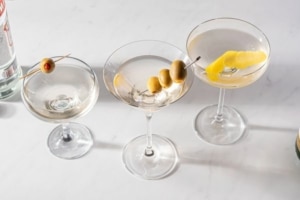DCPA NEWS CENTER
Enjoy the best stories and perspectives from the theatre world today.
Enjoy the best stories and perspectives from the theatre world today.
If the martini is famous for one thing, it’s James Bond. Martinis have become synonymous with seduction and espionage. In the Denver Center Theatre Company production of Rubicon, which tells the story of sultry spy Betty Pack, it’s easy to imagine her sitting at a bar to lure in her next target. Legs crossed, stilettos flashing, hair perfectly coiffed, red lipstick applied, and a martini in her hand.

Pierce Brosnan as James Bond
Bond orders his preferred beverage shaken and not stirred. That’s one of the iconic lines from the film franchise. However, true fans of the Ian Fleming novels will know it’s a reversal of the original quotation. Literary 007 orders his martini ‘stirred not shaken.’ But what’s the difference?
A shaken martini means the vodka or gin and vermouth are added to a shaker with ice, shaken vigorously, then poured through a strainer into a chilled martini glass. The process of shaking the martini dilutes the alcohol, since the ice breaks down and melts in the shaker. This means two things: your drink tastes less strong, and the end result in your glass is cloudy. However, your martini will be truly very cold.
A stirred martini means the spirits are added to a tall mixing glass with ice, then gently but quickly stirred with a barspoon. Then, the drink is poured through a strainer into a chilled martini glass. The alcohol has a purer, more prominent flavor, but the drink is less cold than if it were shaken.
Stirring a martini is the “proper” way to prepare it (just check Wine Enthusiast magazine). Most spirit-forward cocktails, like a Manhattan or a Negroni, are stirred. You’ll find prestige bartenders may stir your drink for an extended period of time – even a minute of continuous stirring. This isn’t to chill your beverage, it’s actually to reach a desired taste. A small addition of water can allow the flavors of alcohol to open and breathe, lessening some of the sharp hits of liquor.
 In recent years, there’s been a surge in creative martini mixing. Most obviously, there’s the choice between a vodka or gin martini, garnished classically with a lemon twist – though gin is the original martini spirit. It’s important to note that all spirits have different flavor profiles, so try a different brand of gin and your martini will taste completely different, especially in a cocktail where the liquor is the star of the show.
In recent years, there’s been a surge in creative martini mixing. Most obviously, there’s the choice between a vodka or gin martini, garnished classically with a lemon twist – though gin is the original martini spirit. It’s important to note that all spirits have different flavor profiles, so try a different brand of gin and your martini will taste completely different, especially in a cocktail where the liquor is the star of the show.
Here are a few other martini adaptations to try:
Vesper: A martini made with both gin and vodka, plus the French aperitif Lillet. This version is also featured in Fleming’s Casino Royale.
Espresso: Add coffee liqueur and espresso to vodka, and garnish with coffee beans. Simple syrup can also be added for a bit sweeter taste.
Dirty: A splash of olive brine is added, plus garnished with the fruit (or an onion!).
Pro tip: if you make martinis at home, fatwash your gin for a rich olive flavor. Choose a high-quality olive oil and mix 2oz with 6oz of your preferred gin. Let it sit for a day, mixing it occasionally, then freeze it. Once the oil has solidified, remove it or poke holes to strain the gin through. Then, use the gin as you normally would.
If making martinis at home does not sound like an ideal evening, make a stop at The Corner Office in downtown Denver. Not only does it serve delicious martinis, this DCPA restaurant partner is offering a special promotion for Denver Center Theatre Company patrons. Before seeing espionage agent Betty Pack onstage in Rubicon, show your ticket to your server at The Corner Office to receive a free martini when you order an entrée.
Other bars whipping up delightful martinis in Denver include Cretans Wine Bar, Chez Roc, Poka Lola Social Club, Range Restaurant, and El Five. Try a variety of flavors from habanero to grapefruit. And unless you want some silent judgment from your server, order your martini “stirred not shaken.”
